CAN THAT THING STING ME?
By Chris Williams on June 11, 2019.
There’s a confusing array of wasps and bees flying about, of all shapes and sizes. Which ones can you safely ignore and which ones could be a problem, now or in a couple of months?
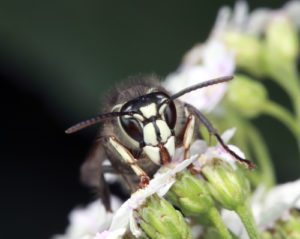
Bald Faced Hornet. Shutterstock.
Solitary bees such as carpenter bees and digger bees are only around for a couple of weeks and won’t be seen again until next spring. But the other social bees and wasps are part of a larger colony and they are just beginning to grow their little communities. They will be around all summer, in ever increasing numbers.
SOLITARY BEES & WASPS ARE MELLOW
Whether or not a bee or wasp attacks and stings when provoked has a lot to do with whether it is a solitary nester or a social nester that is a member of a colony.
We often don’t even notice the activities of solitary bees or wasps, except for the really big ones like carpenter bees or cicada killer wasps. But there are dozens of species of little pollen bees that make individual nests in soil or in crevices, sometimes on buildings. Mud dauber wasps and digger wasps are solitary wasps that make individual nests.
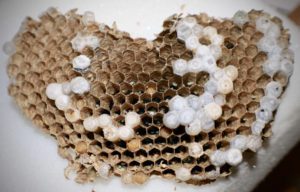
Inside a Paper Wasp nest, we see Eggs, Larvae, and Pupae. Z. Ciras
A single female excavates or digs a nest tunnel in soil or wood, or constructs a nest from mud. Within the nest, she sets up a number of brood cells for her hatching young and provisions each brood cell with pollen (bees) or paralyzed insects (wasps). Nest construction usually takes a matter of days for each nest and once completed, with an egg laid in each brood cell, the female leaves the area.
The female solitary bee or wasp has a stinger and can use it defensively, but she rarely does so. Not being part of a large colony, she is not programmed to expect threats to the nest, plus she is very busy. If you leave her alone, she’ll leave you alone.
COLONY DWELLERS ARE EASIER TO PROVOKE
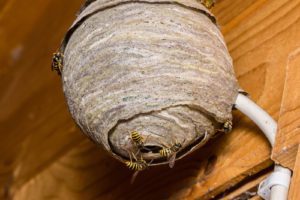
Social Yellow Jackets building their nest. Shutterstock.
Bees and wasps that are part of a colony (known as social bees or wasps), on the other hand, have an extended and growing family to protect. For them, it’s all about the good of the hive and working to produce new fellow sister workers. So, if they perceive that you, or your lawnmower, or your dog, are in any way threatening the nest, they will do their best to discourage your presence – which often involves stinging.
You’re probably already familiar with most of these colony dwellers: honey bees, bumble bees, yellowjackets, paper wasps, hornets. They all nest in a colony nest constructed either in trees or shrubs, below ground, or in building voids or on protective overhangs. Even so, some social bees and wasps, such as yellowjackets, are more aggressive than others in general, or become more aggressive late in the season. Other social wasps, such as paper wasps, are less aggressive and less likely to sting even if challenged…but don’t quote me on that. Like people, some bees and wasps are just more easily provoked.
Sting issues rarely involve solitary bees or wasps. Social bees such as honey bees or bumble bees can be an issue at times, but usually are not. It’s the behavior of social wasps, and especially yellowjackets, that causes the most concern.
– Yellowjacket Nests Grow During the Summer
THEY’RE ALL BENEFICIAL INSECTS, BUT…
You might be surprised to know that both bees and wasps are considered to be beneficial insects. We know that, besides making honey, bees are important in pollinating crops and other plants as they visit flowers, but what do wasps do that’s good? Actually, wasps are also pollinators but to a lesser degree. They visit flowers to find their prey and sometimes to feed on nectar.
The main benefit provided by wasps is that they collect insects and other meats to feed to their larvae. They will sting and paralyze smaller insects and dismember larger prey like crickets and grasshoppers so they can get them back to the nest. Unfortunately, they are not discriminating and will also attack other beneficials such as spiders and honey bees. Social wasps also visit, and help clean up, animal carcasses where they tear off pieces of flesh.
LOCATION, LOCATION, LOCATION
As in real estate, nest location is important, not only for the wasp or bee but for the people who live or work or play nearby. Whether or not wasps or bees are left alone to do their thing or whether there is human intervention with nest building usually comes down to location, and sometimes individual tolerance levels. A yellowjacket nest in the wall void of your child’s bedroom is probably not acceptable, but maybe you can live with a mud dauber’s nest on the exterior wall of the garage.
Nest location around a home can be important if there are small children or pets or someone with a sting allergy living inside. In this case, a social wasp’s nest on the front porch or in the bush next to the deck or in the ground at the base of the swing set could result in stings. It’s not that the wasps like to chase people, but that people who are just doing their thing can end up inside the wasps’ comfort zone and too close to the nest.
– Yellowjacket Nests Too Close for Comfort?
WHO’S THAT WASP BUILDING A NEST ON MY HOUSE?
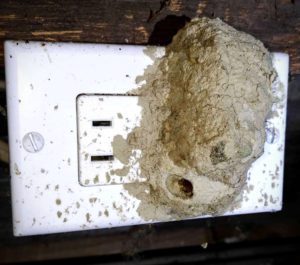
Mud Daubers built nest on electrical outlet in an open barn. Z. Ciras
Mud dauber wasp (solitary) – Large, dark skinny wasps that plaster mud on an exterior wall or beam in the shape of an egg or organpipe tubes side by side. Larval cells inside are provisioned usually with paralyzed spiders. Holes in the mud tubes mean mature wasps have emerged. Nests can be easily scraped off of surfaces.
– Mud Dauber Wasps – Unsightly Nests But Little Threat
In our region, the overwintering queens of the social wasps mentioned below build new nests from scratch in spring. After the queen’s first group of larvae develop, the resulting workers will help feed and care for the next brood, and so on throughout the summer.
Paper (umbrella) wasps (social) – Open-comb nest hangs from a short stalk in protected areas such as porches, under overhangs, soffits, attic rafters or vents, or in equipment. Large, long-legged brown wasps, with yellow markings. However, the European paper wasp is a yellow and black yellowjacket mimic and is more aggressive. Larval cells are added to the edge of the single comb layer so mature nests are limited in size to about 100 workers.
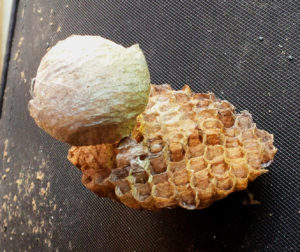
Yellow Jacket nest started to build on a Paper Wasp Umbrella nest. Z. Ciras
– Paper Wasps Are Building Their Nests Now
Yellowjacket wasps (social) –Mature nests consist of several layers of combs and cells, usually covered with a gray papering covering. Often in ground in abandoned rodent nests with opening sometimes hidden; also nest in trees or shrubs or in building voids. Yellowjackets are black and yellow and often feisty. End of season nests can have thousands of workers.
– Where Do Yellowjackets Nest?
Baldfaced hornets (social) –These wasps are technically yellowjackets that have a large, soccer ball-size nest with a gray-brown papery cover usually high up in trees but sometimes in shrubs, under building eaves, or in attics. The wasps look like large yellowjackets but are black and white and tend to interact less with people.
– What Are Those Big, Black and White Wasps?
European hornets (social) – Nests are built in sites such as hollow trees, outbuildings, bird houses, attics, or wall voids. Nest is irregular in shape with several stacked combs and may have a papery covering. Hornets are similar in shape to a yellowjacket but bigger with rust-color markings. They actively hunt insects at night and are attracted to lights.
– The European Hornet is One Large Wasp
EARLY SEASON IS THE TIME TO BLOCK NESTING
It’s always best to discourage or block nesting bees or wasps as soon as activity is noticed. While a single queen may start a nest in spring, it doesn’t take long before there are dozens of workers pitching in to feed hundreds of larvae that will become thousands of wasps. You get the picture! In the Northeast, nests of most social wasps reach their maximum size by August or September and then start to decline. Before that happens, however, yellowjackets can become extremely pesky, scavenging for people food whenever possible.
The good news is that all of the workers die in the fall and wasps don’t reuse their nests the following season. However, every nest that makes it through the summer produces a number of females that are destined to survive the winter and become next year’s queens, each starting her own nest. So for every wasp nest that you have in your yard this year, there may be that many more next year, without intervention.
It follows that nests are easier to destroy earlier in the season when there are fewer wasps or bees to annoy. If you know where a nest is located or just suspect that there is one nearby, call Colonial Pest. We’d rather help you now than later!
There are things that you can do, too, to make your property less attractive to foraging wasps and bees. Things like installing bee guards on hummingbird feeders, picking up rotting fruit or vegetables and canned pet food, and managing garbage cans and recycling bins.
– Should You Remove That Wasp’s Nest Now?
– Make Your Yard Less Attractive to Yellowjackets
SOME SITUATIONS REQUIRE WASP OR BEE CONTROL
We don’t like to kill wasps or bees without good reason but sometimes it is necessary. The following situations call for elimination, removal, or at least prevention of social wasp or bee nesting:
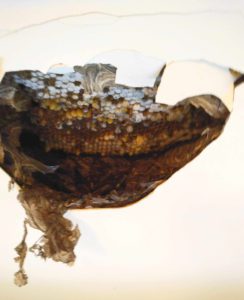
Yellow Jackets nesting in the bathroom ceiling have broken through. Z. Ciras
- When they are nesting in an attic, wall, or ceiling void of a building. Not only is this disconcerting to people within the structure, but sometimes wasps will chew out of the void and enter living spaces. Honey bee nests can ooze honey into void spaces and other insects will infest bee and wasp nests to feed on larvae and comb. Valuable honey bees can usually be safely removed by a beekeeper and moved to a hive box outside.
- When the nest is too close to doorways, walkways, decks, patios, play areas, sheds, or other sites where children, pets, and others might come into accidental contact with wasps or bees. Also, when nests are inside barbeque grills, deck chairs, lawnmowers, boats, or other yard or recreation equipment.
- When a resident or visitor to the home or building is highly allergic to wasp or bee stings, nests that might otherwise have been left alone should probably be destroyed. The chance of anaphylactic shock and possible death from a sting is too great a risk.
- When an outdoor event such as a wedding, barbeque, carnival, flea market, or produce sale is scheduled, and especially if late in the season when nests are larger. If a known yellowjacket nest is nearby, eliminating the nest or trapping the wasps is a good idea especially if food and drink is being served outside.
- When the pests are carpenter bees in the wrong place. These large solitary bees are temporary visitors that chew individual nests into soft, weathered wood around homes. Depending on their nest site and the number of nest-building bees, the cosmetic damage or resulting woodpecker damage may be undesirable. Nesting can usually be discouraged without harming the bees.
– What Are Those Big Black Bees?
If you’re concerned about wasps or bees nesting around your home or in your yard, call Colonial Pest Control for an identification of the pest and an evaluation of the situation. Our technicians can find that elusive nest and destroy it or treat the area to prevent future wasp or bee nesting.
As always, we don’t recommend that you try to eliminate wasps or bees on your own. There’s the potential for things to go bad if you don’t know what you’re doing. Call Colonial. We do pests so you don’t have to!